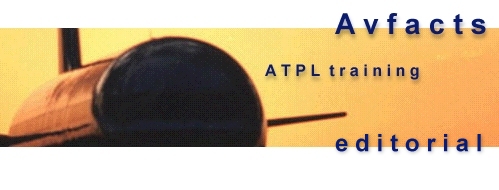




 |
 |
  |
 |
Flight Planning topic 1.
B727 Driftdown
General:The loss of two engines in flight is a very rare event, though it has happened before. When two of the three engines are inoperative, the term used is "driftdown". The B727 can fly on only one engine, though the altitude capability is not high (usually less than 10, 000 ft).
Altitude capability available depends on...
The temperature. High temperatures = lowered altitude capability.
The GW of the aircraft. High GW = lowered altitude capability.
The forward speed demanded by the flight crew (ie: high forward speed = lowered altitude capability).
Prior to flight, the flight crew must satisfy themselves that the loss of two engines will not breach CAO requirements insofar as terrain clearance en-route. The are...
If in VMC, the flight shall clear all terrain within 5 nm either side of the planned track by at least 2, 000 ft.
If in IMC, the flight shall clear all obstacles within 5 nm either side of the flight planned track, or such greater amount dependant on the accuracy of the navigation aids used, by 2, 000 ft.
B727 flight manual
Simplified driftdown planning tables/graphs are at the very back of the flight planning manual, in the emergency ops section, pages 6-1 to 6-3.
After failure of the second engine, the remaining engine is set to maximum continuous EPR limit, and the aircraft is descended at the optimum driftdown speed ( refer table 6.1/page 6-2). This speed is based on the aircraft GW at the start of driftdown, and will assure the maximum air distance from TopD to level off altitude, and maximum level off altitude capability. Essentially we wish to stay as high as possible for as long as possible to reduce the fuel burn, and in doing so preserve the aircrafts 2 engine inoperative range.

Use of tables
To demonstrate these we will use a typical example !
Data: Route Perth (YPPH) to Adelaide (YPAD) direct via Caiguna and Mount Hope VOR, ERC H2 routes B469/T97. Planned cruise level FL330 (all engines operating). Second engine lost 550 nm from Adelaide. Conditions at all levels ISA+5/Wind TAIL 50 kt. Start driftdown GW is 75, 000 kg.
Find:
1. The optimum driftdown speed ?_________KIAS.
2. The approximate level off altitude ?__________ amsl.
3. The approximate fuel burn off during descent ?__________ kg
4. The approximate GW at level off altitude ?___________ kg.
5. The planned flight time from start driftdown point to overhead Adelaide ?___________ min.
6. The planned arrival GW overhead Adelaide ?_____________kg.
7. Can the CAO required terrain clearance be complied with using optimum driftdown speed, without dumping fuel to lighten the aircraft ? YES/NO
8. Can the CAO required terrain clearance be complied with if a higher driftdown/level off speed of M0.8/280 KIAS was adopted ? YES/NO


Question 7.
The highest published LSALT from start driftdown to YPAD is 2, 500 ft. This allows 1, 000 ft minimum terrain separation. For a 2, 000 ft minimum terrain separation required for driftdown purposes, the aircraft must be 1, 000 ft above the published LSALT (ie: 3, 500 ft amsl). As we can hold 4, 900 ft amsl (answer 2) if we adopt the optimum driftdown speed, we can meet the CAO terrain clearance requirements. Answer !
Question 8.
If we adopted a driftdown/level off speed schedule of M 0.8/280 KIAS, we would have to deduct 4, 100 ft off the optimum speed altitude capability of 4, 900 ft. This would give an approximate level off altitude of only 800 ft amsl. We could not conform to the CAO driftdown requirement in this case, unless we dumped fuel.
End of "Driftdown" texts.
